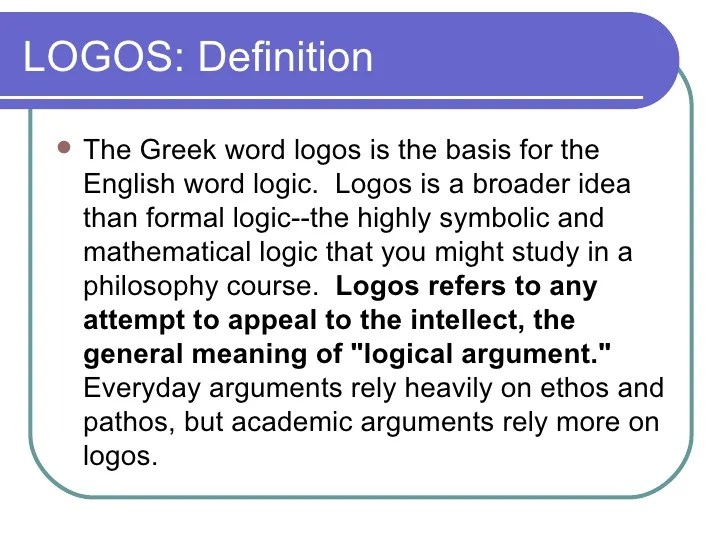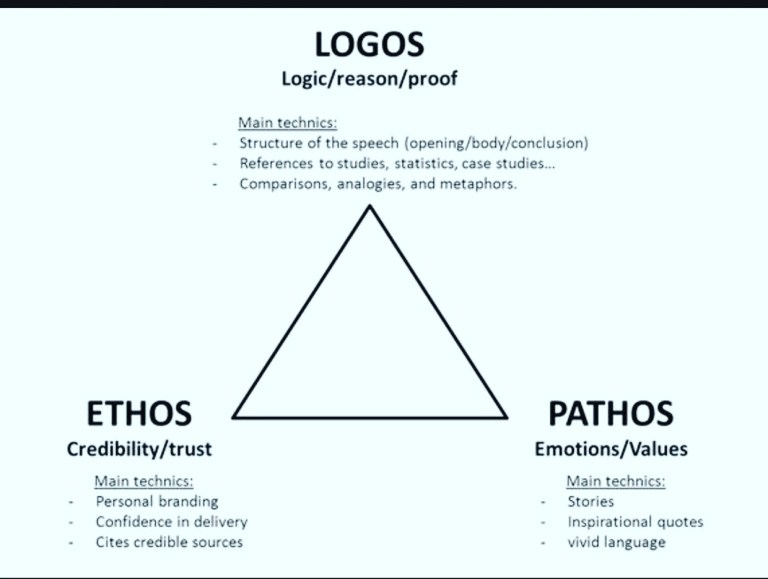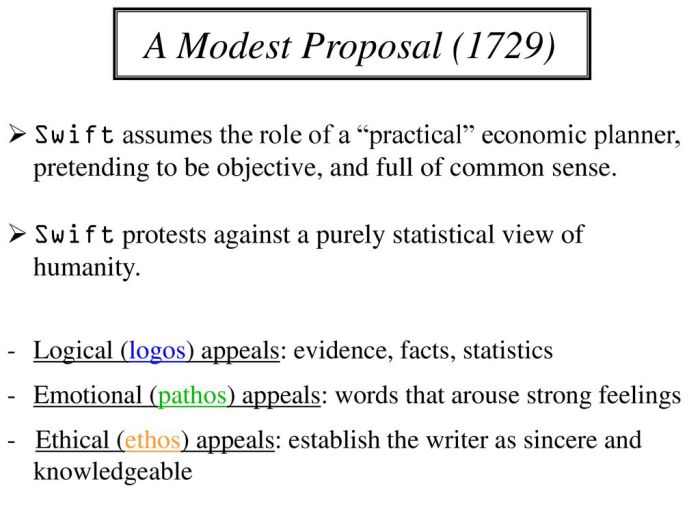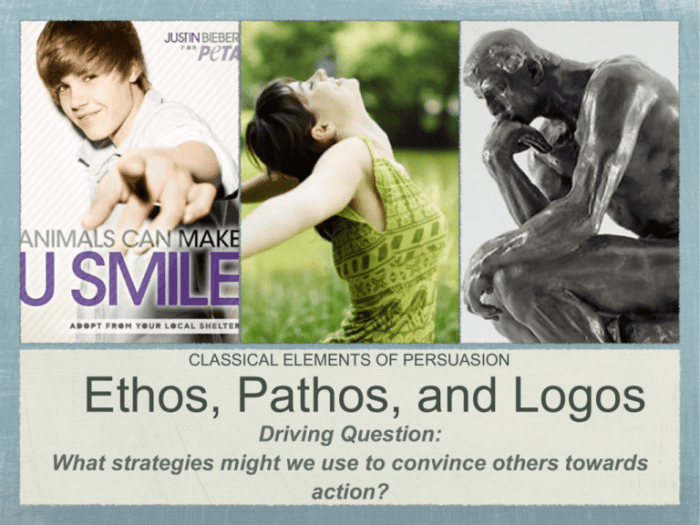A modest proposal ethos pathos logos – In Jonathan Swift’s “A Modest Proposal,” the interplay of ethos, pathos, and logos is masterfully employed to craft a persuasive and satirical argument. This essay analyzes Swift’s skillful use of these rhetorical devices to convey his message.
Ethos

Ethos is a Greek term that refers to the credibility and trustworthiness of a speaker or writer. It is one of the three pillars of persuasion, along with pathos (emotional appeal) and logos (logical appeal). Ethos is essential for persuasive writing because it helps to establish the speaker’s or writer’s authority and credibility on the topic at hand.
There are several ways to establish ethos in a text. One way is to use personal experience or expertise. If the speaker or writer has firsthand knowledge of the topic, they are more likely to be seen as credible and trustworthy.
Another way to establish ethos is to cite credible sources. By referencing the work of experts in the field, the speaker or writer can show that they have done their research and that they are knowledgeable about the topic.
Credibility, Trustworthiness, and Authority
Credibility, trustworthiness, and authority are all important factors in establishing ethos. Credibility refers to the speaker’s or writer’s believability. Trustworthiness refers to the speaker’s or writer’s honesty and integrity. Authority refers to the speaker’s or writer’s knowledge and expertise on the topic at hand.
All three of these factors are important for establishing ethos. A speaker or writer who is credible, trustworthy, and authoritative is more likely to be persuasive than a speaker or writer who is not.
Pathos: A Modest Proposal Ethos Pathos Logos

Pathos is a persuasive technique that appeals to the emotions of the audience. It aims to evoke feelings that will lead the audience to agree with the writer’s argument. Pathos can be used to create a sense of empathy, sympathy, or even anger in the reader.
There are many ways to evoke pathos in a text. One common technique is to use emotional appeals. These appeals can be directed at any emotion, but some of the most common include fear, guilt, pity, and joy. For example, a writer might use a story about a child who is suffering to evoke pity in the reader.
This pity can then be used to persuade the reader to support a cause that helps children.
Another way to evoke pathos is to use sensory language. Sensory language appeals to the five senses, and it can be used to create a vivid and immersive experience for the reader. For example, a writer might describe the smell of freshly baked bread or the sound of waves crashing on the shore.
These sensory details can help the reader to connect with the writer’s argument on a more personal level.
Finally, pathos can also be evoked through the use of vivid imagery. Vivid imagery creates a picture in the reader’s mind, and it can be used to make the writer’s argument more memorable. For example, a writer might describe a scene of a war-torn country or a starving child.
These images can help the reader to understand the writer’s argument on a more visceral level.
Pathos is a powerful persuasive technique that can be used to evoke a wide range of emotions in the reader. By understanding how to use pathos, writers can create more persuasive and engaging texts.
Logos

Logos, an essential pillar of persuasive writing, harnesses the power of logic, evidence, and reasoning to build a compelling argument. By presenting a logical framework, Logos appeals to the intellect and rationality of the audience, establishing credibility and fostering a sense of trust.
Effective use of Logos involves employing sound reasoning, providing concrete evidence, and presenting a logical structure. These elements work synergistically to create a persuasive message that appeals to the audience’s sense of logic and critical thinking.
Examples of Logos in Persuasive Writing
- Citing statistics and research findings:Using reputable sources to support claims and provide empirical evidence adds weight to the argument and enhances its credibility.
- Employing logical fallacies:Identifying and addressing logical fallacies in opposing arguments strengthens the credibility of the writer’s position by exposing weaknesses in the opposition’s reasoning.
- Presenting a logical structure:Organizing the argument in a clear and coherent manner, with a well-defined introduction, supporting evidence, and a logical conclusion, guides the reader through the writer’s reasoning process.
Interplay of Ethos, Pathos, and Logos

Ethos, pathos, and logos are three essential elements of persuasion that work together to create a compelling argument. Ethos appeals to the speaker’s credibility and authority, pathos appeals to the audience’s emotions, and logos appeals to the audience’s reason.
In a persuasive text, these elements are often used in combination to create a powerful effect. For example, a speaker might use ethos to establish their credibility, pathos to connect with the audience’s emotions, and logos to provide evidence to support their argument.
Relative Importance and Effectiveness
The relative importance and effectiveness of each element can vary depending on the context. In some cases, ethos may be the most important element, while in other cases, pathos or logos may be more effective.
For example, if the speaker is an expert on the topic, ethos may be the most important element. However, if the audience is already emotionally invested in the topic, pathos may be more effective.
Ultimately, the best way to use ethos, pathos, and logos is to tailor the message to the specific audience and context.
Case Study: A Modest Proposal

Jonathan Swift’s “A Modest Proposal” is a satirical essay that employs ethos, pathos, and logos to argue for the consumption of Irish children as a solution to poverty and overpopulation. Swift’s use of these rhetorical devices creates a persuasive and emotionally charged argument, effectively conveying his message of social and economic injustice.
Ethos
Swift establishes his ethos by presenting himself as a concerned and knowledgeable narrator. He claims to have “maturely weighed the several schemes” and “found out a remedy” for Ireland’s problems. This persona lends credibility to his argument, as he appears to be an informed and reasonable individual.
Pathos
Swift appeals to the emotions of his readers by vividly describing the plight of the Irish poor. He depicts starving children as “a very burden, a very clog” on their parents and society. This emotional appeal creates sympathy for the victims of poverty and injustice.
Logos, A modest proposal ethos pathos logos
Swift supports his argument with logical reasoning and statistics. He provides calculations to demonstrate the economic benefits of consuming children and argues that it is a “just, reasonable, and easy” solution. This logical approach adds weight to his satirical proposal.
Interplay of Ethos, Pathos, and Logos
Swift’s skillful combination of ethos, pathos, and logos creates a powerful and persuasive argument. His use of a concerned narrator, emotional appeals, and logical reasoning effectively conveys his message of social and economic injustice. By presenting a seemingly absurd proposal in a serious and logical manner, Swift highlights the absurdity of the actual situation in Ireland.
Top FAQs
What is ethos, pathos, and logos?
Ethos refers to the credibility and trustworthiness of the author, pathos appeals to the emotions of the audience, and logos employs logic and evidence to support the argument.
How does Swift use ethos in “A Modest Proposal”?
Swift establishes ethos by presenting himself as a concerned and knowledgeable narrator, using his authority as a respected writer to lend credibility to his argument.
What is the role of pathos in Swift’s essay?
Swift evokes pathos by appealing to the emotions of his audience, using vivid imagery and sensory language to create a sense of shock and outrage.
How does Swift employ logos in his argument?
Swift uses logos by providing logical reasoning and evidence to support his proposal, such as statistics and historical examples.